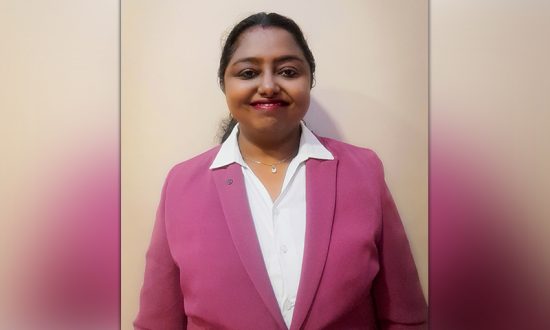A dedicated, resourceful and goal-driven professional educator with a solid commitment to the social and academic growth and development of every child, Dr. Pushpita Chattopadhyay is an academician par excellence. PhD, M.Sc., MA in Education, B.Ed, PG-Diploma in Instructional Designing, PG Diploma in Education Management, Cambridge Certification programme, A- Level and Higher Diploma in Computer science are few of the laurels in her crown.
Pedagogy of the twentieth century differs from the pedagogy of the twenty-first century in drastic ways. From rote learning to learner centric approaches, from theoretical knowledge to practical hands-on experiences, from teacher oriented to student oriented, from memorization to innovation, we have come a long way. The new century led to substantial changes in teaching methods and didactics. The educational space is expanding beyond the classroom; the fact that students are able to access almost any information at any time from an early age changes the structure of mnemonic processes. This has occurred due to flexible use of digital media as opposed to traditional media, the ability to multitask, and use of intellectual ICT tools as compared to pure mental performance, use of one click internet searches as against limited textbook content, working on screen and extended networking rather than the limited classroom interactions. All this has led to a scenario where knowledge acquisition has taken shape of knowledge creation. To keep such an audience engaged is a herculean task for the teachers and so there is no other option but to innovate the pedagogy and teaching methods as per the requirements of the students of new generations.
The theories of education right from behaviourism to cognitivism and constructivism need to inculcate connectivism. Thus, the source of knowledge is now changing from just experience, to mindful experience with reasoning. Add connection to the whole gambit and you have a pedagogy that contains the essence of the Generation Z.
The active use of innovative teaching methods by teachers, motivates students, promotes in-depth learning and shapes their experience of solving nonstandard problems. All this can be achieved by the steady assimilation of technology and practical activity-based classrooms. A good teacher continuously advances his/her didactic skills, develops and selects innovative technologies and methods of teaching.Use of innovative methods of teaching such as these will definitely engage all types of learners
Gamification
Engagement is an essential element of learning. There is no better way than to teach through games, through enticing characters and intriguing situations where the students want to stick around till the end of the story, without overshadowing the concept or pedagogy.
Collaborative Learning
Gone are the days of learning in isolation at home just before exams. Every student is now a part of a group as they help each other to reach the desired result. Learners develop skills to listen to others and work in a team. They learn to tolerate others’ opinions and even meet different people to get a genuine review of their work thus allowing them to exchange their creativity and gain more knowledge. In return, it aids them to learn to face healthy criticism and cross-examines. It is time to replace desks with interactive whiteboard surfaces, thus helping groups to work together with ease.
Flipped Classroom
Flipped Classroom is a renowned term in the pedagogical technique. The method is the converse of providing content at school. In a flipped classroom, students watch a video tutorial, research online or work on the content shared by the teacher at home. They then solve class assignments based on this content in school. Students prepare themselves with the content before arriving in school, and if they face any doubt, they can discuss it in the classroom and resolve their queries. They can also recommend their ideas related to the content and share it with the classmates. Through the practice of flipped classroom, students get enough time to grasp the topic.
Spaced Learning
‘Spaced learning’ is a comparatively new methods introduced in the teaching learning process. Here, the teachers repeat the same lesson multiple times but at spaced intervals.
The gap is intended to rejuvenate the mind by playing physical activities or mindfulness methods which prepares them for the upcoming session of the same lesson. This method gives the students intervals to inherit the knowledge and create connections between repetitive sessions, before moving forward to another chapter. This method is best used to prepare the students with basic concepts.
Crossover Learning
Crossover learning uses both informal and formal learning and teaching environments. This method involves using a formal classroom setting to teach content and provide study materials to add knowledge and then using the informal environment of teaching in museums, seminars, and after-school places to generate curiosity and interest through questioning.
Self-learning
Teaching students to navigate the internet or research information in libraries and find results themselves helps them to be self-dependent and gives them a deep understanding of the content. Through their curiosity, students get motivated to explore the subjects of their interest.
VAK teaching
Having its roots in the Multiple Intelligence theory, VAK is a modern teaching method. Learners are categorised into three divisions: Visual(learning by seeing the data), Audio(gathering information by hearing the data), and Kinesthetic (learning by movement or by feeling the data). Teacher needs to recognize the kind of learner and then present the same material in different ways.
Being in the 21st century, there is an urgent need for educators to figure out the best ways for learners. The need of the hour is to introduce technological, economic, and cultural force in the education system at all levels and change the core of the traditional educational system to promote experiential learning. At Birla Brainiacs, we have adopted most of these innovative pedagogies to develop the self learning habits and helping them to become life long learners.




